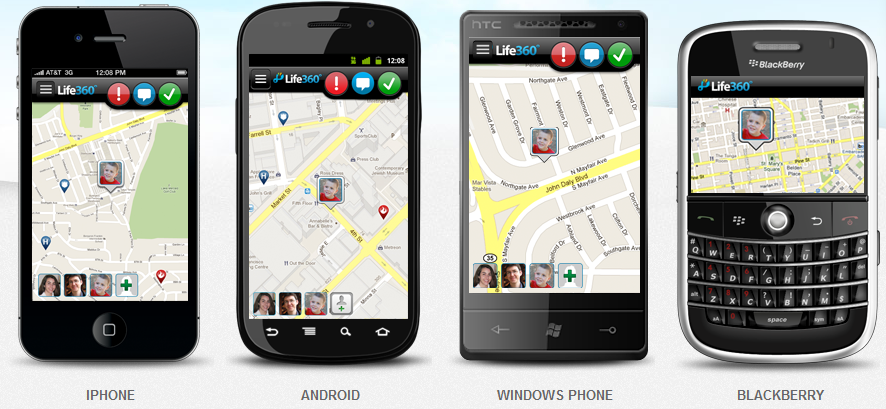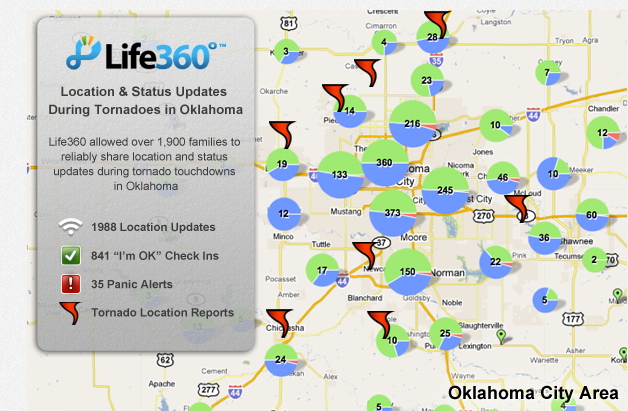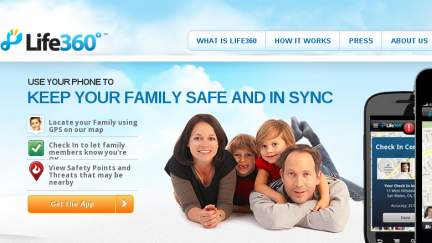 Oct. 15, 2012 Teens call them ‘trackers,’ parents call them ‘tools,’ and the telecom industry refers to GPS and LBS (location based services) as sheer “growth” in a mobile market that’s booming with map-based apps that pinpoint the whereabouts of users.
Oct. 15, 2012 Teens call them ‘trackers,’ parents call them ‘tools,’ and the telecom industry refers to GPS and LBS (location based services) as sheer “growth” in a mobile market that’s booming with map-based apps that pinpoint the whereabouts of users.
We need to uncork this whopper of a conversation beyond the micro (oooh, handy! or ewww creepy!) and into macro (pros/cons, critical thinking) to compare short term gains with long term losses…
If you view the convenience and parenting ‘peace of mind’ of family locator apps for example, you should also force yourself to see the slow erosion of self-directed responsibility, street smarts, impact on trust within relationships, and reliance on screens with get me outta here style panic buttons. I’m interested in mapping these kinds of questions themselves; holding possibility and promise alongside privacy and privileges, determined to guide how new media weaves itself into the fabric of our worlds to fit our own form and function.
In a digital world where devices are delivering data to someone, somewhere 24/7, (marketers, media, moms, etc.) it’s imperative to hold ‘the next big thing’ up to the light to see where the shadows fall.
Truth is, invisible fences give the illusion of more leeway, while layering in new complexities that have the potential to impact life literacy, risk management and personal agency.
21st century parenting is rife with tech cavalry blowing its horn to the rescue…
Solutions, quick fixes, helpful life hacks, issue-specific resource round-ups ranging from “Cool Gadgets That Let You Monitor Teen Driving” to the promise of a parental exhale and “worry free parental controls.”
The new MamaBearApp monitors kids’ whereabouts, their ‘friending’ on Facebook and word choice implying bullying or danger… (“Know where they are, what they’re saying, who they’re with”) and even Time magazine’s recent article was sniped with the revealing search engine descriptor, optimized as “Smart phone apps can help parents track children’s movements, activities.” It made me flinch, realizing that their keyword choices were purposely selected as a strong bet that parents are seeking ongoing support in this realm. It feels like tech tethers of a new generation of digital kids are tightening like shackles but they’re so soft and subtle they’re not feeling it, and parents aren’t seeing it. At least not yet.
Tech Tethering Childhood: Tales of Puppy Expando-Leashes
Somehow we seem to have cultural short term memory loss on fear-based protectionism and how the desire for safety largely got us here in the first place…Remember when “free-range kids” started being over-organized into play dates as humans slowly crated and gated themselves into self-protected communities? It took a toll on neighborhoods, outdoor play and childhood freedoms, which we’re still struggling to get back.
It explains a lot about why child location GPS systems and LBS-kids apps have become the tech equivalent of a puppy expando-leash, with parents eager to ‘let out’ the stress of being tightly wound, while reassuring themselves they’re ‘in control’ and vigilant 21st century parenting style. Sure, the tech gizmos can be ‘cool’ and usable, and convenient, and for some they’ve reached ‘savior’ status, but we need to ask the right questions of the apps and of ourselves, mindful of how we’re using new media in new ways with relationships…
What are the upsides AND the downside of digital reliance? What are the socio-emotional costs? I can’t help but wonder about our new “terms” of endearment.
Booker T. Washington said, “Few things help an individual more than to place responsibility upon him, and to let him know that you trust him.” Hmn.
 Living Life 360: A Two-Part Peek Into Pros/Cons of Locator Apps
Living Life 360: A Two-Part Peek Into Pros/Cons of Locator Apps
On the positive side of life lessons and trust, I chose to focus a two-part series on Life 360 not only because it’s the aptly named marketplace leader, but because I began ‘tracking it’ and testing it with teen volunteers in hands-on trials way back when it was racking up reportedly about 10 million users…yet I couldn’t find anyone in my direct sphere using it.
I began wondering, ‘who ARE these people and who’s using this tool?’ (especially watching it surge from its initial launch in 2008 to a reported 20 million users today, skyrocketing from 13 million in March 2012 when it was featured on Business Insider as ‘almost as big as foursquare, but unheard of’)
I was also curious about HOW people were using Life 360, because I read a lot of ‘ooh this is cool’ testimonials from parents of small kids across the interwebs, without much applied science in terms of how apps like these actually function within families, in terms of outcomes. I wanted to know more…
Why wouldn’t someone just text instead?
Turns out Life 360 offers free messaging to keep texting costs down (which makes sense for those on limited/shared family texting plans, removing the “I didn’t want to add to my SMS count” excuse)
Similarly, the iconic symbols popping up on the map as ‘safety points and threats’ (police, fire, ‘sex offender’ database) gave me pause, wondering how the heck one might explain those fear-based little ditties to a child…I thankfully found out they’re ‘hidable’ so lil’ junior doesn’t have to encounter them, and parents get a hallpass from explaining in TMI mode.
I’ll get into more of the pro/con what works/what doesn’t features from my own point of view later, for now, Life 360 CEO Chris Hulls shares our e-interview for a glimpse beyond Life 360 FAQs. In Part Two, I’ll share an eight month compilation of our firsthand family experiences and tales of our teen volunteers tasked to use Life 360 (directive was to ‘mess with it periodically’ and report back). It’s been a lot of fun.
You’ll begin to see whether or not it fits into your own family’s media mix, with insights ranging from some surprising ‘trust triumphs’ to some hilarious and colossal misunderstandings and ‘mapping mop ups’ that tugged at the fringes of fear.
If there’s one over-arching ‘take away’ to impart in assessing Life 360 (or any ‘tracking’ tech tool) it’s that parents REALLY need to be brutally honest with themselves about their own motivations and expectations using LBS-apps.
Family relationship dynamics run the gamut, and those trying to assuage their own fear, angst, or parenting insecurities need to be aware apps like these can CREATE them as well.
Do an honest ‘gut check’ to your own reaction of this Life 360 pop up screen:
“COULD NOT LOCATE” (big bold type)
Due to one of the following reasons:
- This device is out of range
- This device is turned off or the battery is dead
- The user you are locating has an older version of the app
Heart racing? Or shoulder shrug with a ‘meh, I’ll just send a text instead, s/he probably forgot to charge it?’
Does it depend on the age and stage of the child? Your own trust bonds and personal relationship? Adolescent behavioral patterns?
These are the types of personal ‘check-ins’ parents need to do with themselves BEFORE they use LBS-safety tools.
And no, there’s not ‘an app for that.’
Interview with Chris Hulls, CEO of Life 360 by Amy Jussel, Shaping Youth
Amy Jussel, Shaping Youth: How would you address those that feel this is shifting discipline to technology and creating dependence on safety check in and reminder tools over personal accountability/independent follow through?
Chris Hulls, Life 360: It’s important to reiterate that Life360 is not meant to replace talking with your children. It is a tool to keep families in touch with each other when a phone call may not be necessary. Our data shows that the majority of parents reach out to connect with their children multiple times per day. It may be to confirm that their child arrived safely at school, caught the bus to soccer practice, arrived at soccer practice, to check on why they are not home yet or where they are when out with friends.
Certainly parents are still calling their children to connect during the day, but sometimes a phone call is not necessary or even possible. Many schools, for instance, will not allow children to answer their phone on campus during the school day. As long as the phone is on, Life360 runs in the background and can provide parents with a location update.
Technology has become such an integral part of our daily lives, and youth are among the earliest adopters. Because kids today have grown up with technology, parents have had to lay down ground rules early on around what role technology plays in their own household. Those rules are different for every family, but we tend to see that children are acutely aware that having a mobile phone is a privilege that comes with its own set of responsibilities and expectations. Checking in through Life360, for example, is an exercise in building and maintaining responsibility.
Amy Jussel, Shaping Youth: Should parents be ‘tracking’ kids at all? What kinds of families are using this app most? (e.g. latchkey/rural-urban, age-groups, etc)
Chris Hulls, Life 360: Our largest user segment is families with teens. We see all types of families use the app – urban and rural, stay-at-home and working parents. Most parents explain to their initially skeptical teens that by using Life360, the kids will receive fewer embarrassing phone calls from mom and dad and can stay out a little later. Some parents say, “You can stay out until 11:30pm with your friends, as long as you “check in” every couple of hours and every time you change locations.
Amy Jussel, Shaping Youth: Does your family use this tool? And if so, what were the barriers to entry in terms of use and at what age are you seeing it most deployed? (e.g. Would a teen willingly ‘sign on’ to check-in? Or do they run it in the background and risk battery drain?) What are some of the practical pros and cons of using LBS/GPS safety apps with kids?
Chris Hulls, Life 360: Yes, everyone on the Life360 team uses our app, myself included. While the largest segment of our users are families with children old enough to have their own smartphones, we see many others using the app as well. For instance, I recently used the app to stay connected with my sister as she biked across the country by herself. Naturally, I was worried about her safety and Life360 enabled me to know where she was and that she was safe throughout the duration of her adventure.
We see families with children who are off at college use the app. We also see spouses use the app with each other. Let’s say your spouse travels a lot for work. It can be reassuring to know where he or she is and that he/she arrived safely wherever it is they are traveling to today. There are dozens more examples of types of family units we see using the app, but you get the picture that Life360 can be valuable for many types of users.
As I mentioned before, parents tell us that their kids appreciate the freedom they have when using Life360 to check in, so we do not see many kids turning the app off. There are also settings to turn off or run the app in the background; meaning it can either track your location as it changes or you can actively share your location with a check-in. We are constantly improving the product and its features and are proud to say Life360 has a minimal effect on battery drain.
Everyone being located by our app has given permission to do so and can easily revoke that permission at any time. Our app is family focused and only people you have invited to be a part of your family channel can view your whereabouts and connect with you; plus we have bank-level protocols to protect your data.
Amy Jussel, Shaping Youth: Do you feel there’s ever a ‘false sense of security’ established with apps using ‘panic buttons?’ Is it programmable to be tethered directly to 911/fire/police or does it always route through the parent/primary provider? (For example, if a youth hits ‘panic’ forgetting their school uniform, it just goes to the parent, right? 😉
 Chris Hulls, Life 360: First, let me explain how the Life360 panic button works. If you press the panic button within the Life360 app, first, there is a 10-second countdown (so you cancel out of the panic alert if the button was pressed by mistake). Then the panic alert is sent to every member of your Family Channel.
Chris Hulls, Life 360: First, let me explain how the Life360 panic button works. If you press the panic button within the Life360 app, first, there is a 10-second countdown (so you cancel out of the panic alert if the button was pressed by mistake). Then the panic alert is sent to every member of your Family Channel.
Our app uses every method of contact we have available to reach your family members. We’ll send a text message, a push alert through our app and a phone call with a message that you need help and need to be contacted immediately.
After pressing the panic button, there is a button to call 911 if that is needed. Many times a family emergency does not necessitate a call to emergency responders like the police or fire department.
For instance, we see the panic button feature is most used during local emergencies and natural disasters when families are worried about each other and want to make sure their loved ones are safe. We see a huge spike after earthquakes, tornadoes, floods and other disasters.
Amy Jussel, Shaping Youth: What’s the difference between the FREE app and the $4.99 premium version beyond what’s listed? Any new uses in the works?
Chris Hulls, Life 360: Our app is free for Android and iPhone users. The vast majority of our user base uses Life360 for free. For families that want to track non-smartphones, there is a $4.99 monthly fee. The most common scenario where this would apply is when a teenager is given a cell phone, not a smartphone, and parents want to use Life360 with their child. Users of non-smartphones must give permissions through text message and can revoke their permission at any time. We’ve evolved quite a bit since we founded the company, and will continue to explore new features and ways to make the app even more helpful to our users on a daily basis, but until we’re ready to announce new features, we cannot comment on development plans.
Amy Jussel, Shaping Youth: While I understand Life360 is positioned as a 21st century tool for tracking kids whereabouts for safety BY parents on an opt-in basis via private family network, could you explain how that data is protected against marketers, peer misuse/bullying, GPS/LBS issues w/smartphones in general—and address current LBS privacy legislation in the Senate?
Chris Hulls, Life 360: Every phone on the account must first be invited by an admin and then give permission to be located (protecting both users from someone trying to sneak onto the channel or from someone following you unknowingly). Furthermore, everyone on the channel is visible on the map—there’s no anonymous viewing (which is largely what the Senate is currently debating). As a company, we have a strong commitment to protect the personal data of our users. We do not sell our users’ data.
Amy Jussel, Shaping Youth: Life360 has/had significant backing from Google, could you explain those ties? Did Life360 morph from Google’s Latitude? Do you have carte blanche w/Google Maps and if so, how do parents know Google isn’t data-mining LBS/whereabouts/personal uses of the app for their own monetization purposes?
Can you reassure parents you are a safety/LBS only app vs partnering with commercial ventures/corp retail mobile mapping etc, and if so, is this in your Terms of Service?
Chris Hulls, Life 360: Our connection to Google comes from winning the Grand Prize in its first Android Developer Challenge. It was a great opportunity for us to get early access to the Android platform and we are in touch with Google’s developer relations team. We are an independent company, however, and we use the same open APIs as other app developers when it comes to Google Maps.
You would have to contact Google about what they do with their data.
We will always protect the privacy and safety of our users and our terms of service state that will never sell users’ data unless we ask them first. Our plans for development are strictly focused on adding features to Life360 that will make it even more helpful for family units. There are no plans for retail mapping or ads.
(Amy’s editorial comment: Note to self: above statement definitely requires a follow up with Google on LBS-data handling and kids)
Amy Jussel, Shaping Youth: How do you differentiate in an increasingly crowded mobile marketplace as a ‘family app’ at the carrier level and how were you able to establish those ‘buy-ins’ from corp telecom, instead of them each marketing ‘safety apps’ for themselves? Was that the Google maps clout?
Chris Hulls, Life 360: While we try to make everything about Life360 easy, the truth is that the underlying technology is complex and requires a lot of specialized talent to run smoothly. Carriers have also moved away from “walled gardens” to opening up their APIs to app developers because they see that’s how to retain and gain customers. Some of the families using Life360 have told us that they heard about our app through major carriers’ retail store representatives who ‘upsold’ parents on getting their children smartphones.
Amy Jussel, Shaping Youth: Could you talk about the “check in” vs “update” button and push vs pull technology?
Chris Hulls, Life 360: In terms of push vs. pull technology, it is up to parents and their children how they choose to use the app. In the app settings, you can select how often you want the app to refresh your location. It could be every 15 minutes or every 2 hours, for example. When it comes to the check-in feature, we find that most parents request a check in from their child, but it is possible to hit the “update” button and obtain any family member’s location at any time if you choose (as long as the app is running). It is valuable to have the ability to do both. Requesting a check in is a sign of mutual respect, but if a family member does not respond to a check-in request or there is a reason to be concerned about their safety, it is very helpful to have the ability to update their location.
Amy Jussel, Shaping Youth: If/when there’s a glitch (e.g. data is inaccurate/pulling up a prior destination or when you have the person sitting next to you and it says they’re elsewhere from last point of contact, which we’ll share more about in Part Two) how can the phones best be ‘cleared’ to reset…toggle off? Reboot? Clear maps in use?
How can people troubleshoot for a more accurate read vs a child arguing “but I’m not there I’m here, I don’t care what it says” which can wreak havoc with trust? (It seems check-in is more technically accurate location-wise than ‘update’ which can be several thousands of ‘feet away’ and random)
Chris Hulls, Life 360: Turning on WiFi can increase the accuracy of GPS technology, but in the end, our app relies on GPS or carrier location data. Fortunately, it is improving all the time and we are continually working to improve location accuracy as the technology develops further. The vast majority of the time, we see that locations are reported within several hundred feet of where the user is located.
Amy Jussel, Shaping Youth: Finally, who do you consider to be your top three mobile app contenders doing similar work in this realm and what makes you different?
Chris Hulls, Life 360: In the location-based app space, Life360 is not only by far the leader with more than 20 million registered users, we are the only app that focuses primarily on families. Apple’s Find My Friend app focuses on use among friends. Guardly focuses on university students and people who work alone, like real estate agents. There are also white labeled safety apps promoted by the largest mobile carriers.
 Amy’s note: There are plenty of media stories touting the usual Halloween trick or treating “download the free app, keep the kids safe” angle of apps like Life 360, SecuraFone’s CBS footage of little goblins (“scary” how many of these have ‘appeared’ just this week alone!) so feel free to add more in the comments below as you hear of them.
Amy’s note: There are plenty of media stories touting the usual Halloween trick or treating “download the free app, keep the kids safe” angle of apps like Life 360, SecuraFone’s CBS footage of little goblins (“scary” how many of these have ‘appeared’ just this week alone!) so feel free to add more in the comments below as you hear of them.
Currently Life 360 is the behemoth in the bunch of this recent Time magazine roundup “Should You Use a Smartphone to Track Your Kids? but I’d love to keep an eye on ‘monitoring the monitors’ to see who’s using what and hear all ages sound off with their own views.
Please leave a comment with screen scene updates, or tweet to me @ShapingYouth to share your pros/cons and add to the conversation on family locator apps…
How do YOU feel about kids’ tracking and mobile mapping within the family?
To paraphrase in non-Seussical silliness, “Would you, could you…with a teen? With a tween? And not be seen? Do you say that it is grey, or come what may, no way, José?”
Stay tuned for Part Two with a ‘hands-on’ lighter look at LBS-safety apps from a teen tribe of volunteers/parents sharing their own versions of “Life 360” stories.











Will you have life 360 family locator for windows 8 phones?
You’ll have to ask the company, Mike…I’m just testing it out in my own home and w/our teens team…They’re at Life360.com
I’ve tried looking everywhere online to find out what some of the icons mean. Any help, please?!🙏🏼
Hi Chantelle, it’s been ages since I’ve used the app and it’s updated considerably with new features using “circles” for everything from connections to driver events and caregiver data, so I’d check their support site directly.
A quick google search w/your query, “what do Life 360 icons mean” gave me this visual snapshot which is a far cry from where it was in 2013 when I wrote this post and tested it out…but here ya go:
https://www.google.com/search?sxsrf=ACYBGNTlZ64q198SxRk9wziHlP1lPHo9Qg:1574826077066&q=life360+icons+meaning&tbm=isch&source=univ&sa=X&ved=2ahUKEwiy8Z-nvInmAhXICjQIHWOECU4QsAR6BAgFEAE&biw=1440&bih=648
Hi,
In designing the mobile app, we face lot of difficulties and also trends will be changing on and off.. we have to be update ourself all the time